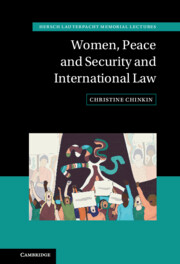Book contents
- Women, Peace and Security and International Law
- Hersch Lauterpacht Memorial Lectures
- Women, Peace and Security and International Law
- Copyright page
- Contents
- Acknowledgements
- Documents
- 1 The Women, Peace and Security Agenda
- 2 Women, Peace and Security in International Law
- 3 Women and Peace
- 4 Women and Security
- 5 Conclusions
- Index
2 - Women, Peace and Security in International Law
Published online by Cambridge University Press: 17 March 2022
- Women, Peace and Security and International Law
- Hersch Lauterpacht Memorial Lectures
- Women, Peace and Security and International Law
- Copyright page
- Contents
- Acknowledgements
- Documents
- 1 The Women, Peace and Security Agenda
- 2 Women, Peace and Security in International Law
- 3 Women and Peace
- 4 Women and Security
- 5 Conclusions
- Index
Summary
I turn now from the brief overview of the substance and institutions of the Women Peace and Security (WPS) agenda to ask what WPS means for international lawyers. The language of the WPS resolutions is not that of international law but primarily that of international relations (‘international peace and security’), good governance (‘participation’, ‘monitoring’, ‘indicators’, ‘reporting’) and development (‘empowerment’, ‘leadership’) with subsets of these disciplines such as conflict, security and peace studies. And, of course, the language of gender permeates the resolutions, albeit largely as a synonym for women and girls. The state-centric emphasis of international law is softened by calls for relevant actions by diverse actors as well as states – international institutions, international personnel, men and boys, civil society. The agenda seeks to shape behaviour, policy and decision-making by all these different actors as well as by states, which raises the question of whether the WPS resolutions create binding obligations under international law, which is the subject of this chapter.
- Type
- Chapter
- Information
- Women, Peace and Security and International Law , pp. 38 - 70Publisher: Cambridge University PressPrint publication year: 2022

